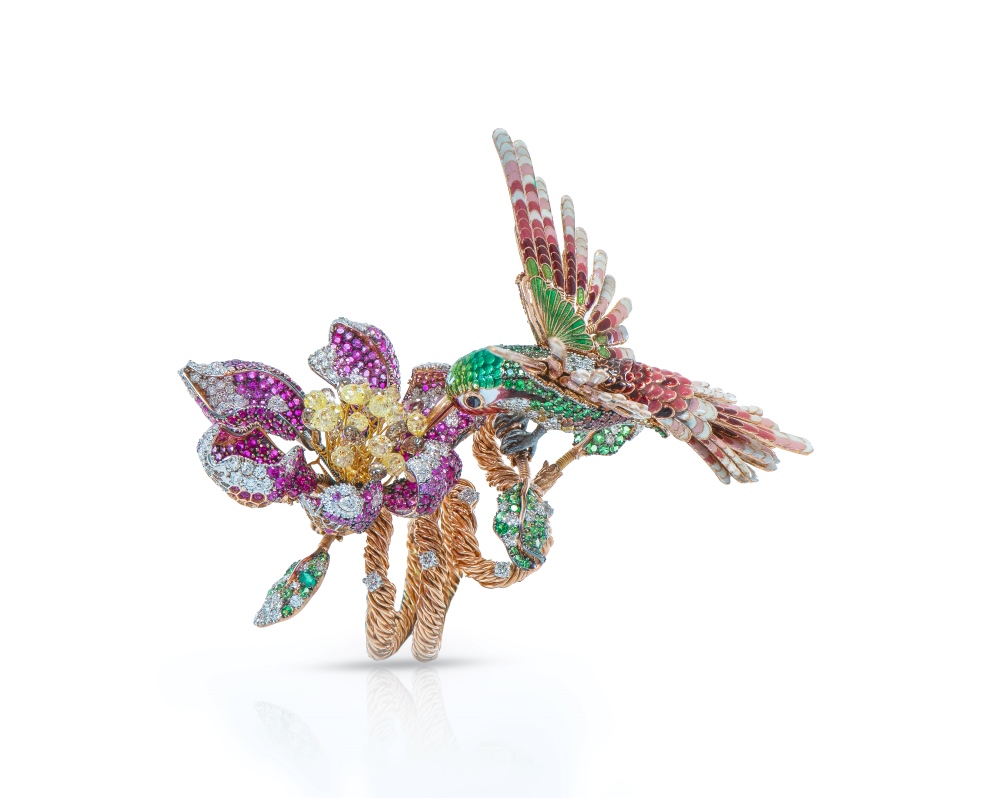Founded in 1895 following the marriage of Alfred Van Cleef and Estelle Arpels, the Maison has become renowned for its poetic style and technical innovation since opening its first boutique at 22 Place Vendôme in 1906. At the 1925 Paris Exhibition, Van Cleef & Arpels was awarded the Grand Prize for exceptional creations, including the floral-inspired 1924 Entwined Flowers, Red and White Roses bracelet, which is now on display in Tokyo and represents the Maison’s unique interpretation of Art Deco.

Hosted at the Tokyo Metropolitan Teien Art Museum, formerly the residence of Prince Asaka, the exhibition presents over 250 creations, from High Jewelry and timepieces to precious objects—drawn from the Maison’s Patrimonial Collection and private collections, alongside 60 archival documents.
A significant selection of Art Deco masterpieces from the 1910s to 1930s is displayed in the museum’s Main Building, while the Annex highlights Van Cleef & Arpels’ emblematic savoir-faire, including gold work, transformability, Mystery Set, enamel, and gemstones sculpting.
Marking a century since Paris’ landmark Art Deco exhibition, Timeless Art Deco with Van Cleef & Arpels High Jewelry offers an opportunity to explore the evolution of this artistic movement and the Maison’s precious interpretations over the decades.
Chapter 1
Emergence of an Art Deco Aesthetic
Chapter 1 presents a selection of High Jewelry creations from the early years of the Art Deco period, including pieces awarded the Grand Prize at the 1925 International Exhibition of Modern Decorative and Industrial Arts.

The rose is one of the iconic motifs of Art Deco. This Entwined Flowers, Red and White Roses bracelet features red and white roses, while the Rose brooch showcases a single white bloom. Both pieces skillfully incorporate stylized elements of buds, leaves, and thorns, reflecting the Art Deco aesthetic of geometrized natural motifs. The bracelet, among other creations, earned Van Cleef & Arpels a Grand Prize at the 1925 Art Deco Exhibition.

Can be worn shorter, detachable pendant
This long necklace, inspired by Asian imagery, is adorned with colorful gemstones. The piece harmoniously combines geometric patterns with motifs reminiscent of the Japanese art of flower arranging, ikebana, blending Eastern spirituality with the beauty of Art Deco style. The pendant can be detached, and the chain is decorated so it can be worn on its own.
Chapter 2
Evolution towards a Singular Style
Chapter 2 explores a new sculptural language in jewelry characterized by a quest for volume and three dimension. White creations also attest to the importance of diamonds and platinum.
This collaret necklace was made at the end of the 1920’s. The neckline is adorned in diamonds and platinum, from which dazzling emeralds weighing a total of 165 carats descend. The piece attracted a great deal of attention when it was exhibited in a French pavilion at the Brussels International Exhibition of 1935 in Belgium. Seeking to convey three-dimensionality and incorporate a variety of materials, it still shines today as a style that combines boldness and sophistication.

Chapter 3
Modernism and Functionality
Chapter 3 presents jewelry creations and accessories that embody the spirit of Modernism distinguished by abstract geometric forms and functional elegance.
Patented in 1933, the Minaudière is a case that holds a mirror as well as a lipstick, a powder compact, a cigarette lighter, a notebook, and other items that women needed when going out. It can be tucked into an evening bag or carried as a clutch. The Camellia clasp on this piece can also be detached to be worn as a clip. With its sophisticated, beautiful design, the highly functional Minaudière has become one of Van Cleef & Arpels’ most emblematic pieces.

The Cadenas is a wristwatch shaped like a padlock, cadenas in French. Since it was first created in 1935, this bold, modern creation has become one of the Maison’s emblematic pieces. With its angled dial, the timepiece was designed to look like a bracelet at frst glance, allowing women to unobtrusively check the time during an era when it was considered impolite in public.
Chapter 4
Garden of Savoir-faire
Chapter 4, presented in the museum’s annex, highlights the savoir-faire that Van Cleef & Arpels has preserved and perfected to this day. Visitors are invited to embark on a journey through five poetic garden scenes, brought to life by jewelry inspired by the flowers and animals cherished by the Maison.

This is a clip in the shape of a vibrantly blooming chrysanthemum. The luxuriant ruby petals curve inwards, capturing the complexity and intricacy of the flower. This creation showcases the Mystery Set, a technique patented by the Maison in 1933. The method consists in setting the gemstones while rendering the mounting invisible. By covering the surface, the stones produce a velvety interplay of light and color. The piece was highly acclaimed when it was shown at the International Exhibition of Art and Technology in Modern Life held in Paris in 1937. France has been greatly influenced by Japanese arts since the 19th century, and the chrysanthemum has been a recurring motif.

Transformable into a bracelet
The Zip necklace stands out for its ingenuity. The design allows it to transform into a bracelet by simply sliding the fringed tassel and zipping it closed. Originally inspired by the zipper fastener, used in the fashion industry, this piece attests to the in uence of couture on Van Cleef & Arpels. The Zip necklace was patented in 1938, and the frst transformable jewelry pieces were produced in 1950.

About Van Cleef & Arpels
Founded at Paris’ 22 Place Vendôme in 1906, Van Cleef & Arpels came into being following Estelle Arpels’ marriage to Alfred Van Cleef in 1895. Over the decades, the excellence and creativity of the High Jewelry and Watchmaking Maison established its reputation across the world. With a blend of inventiveness and poetry, Van Cleef & Arpels perpetuates a highly distinctive style that has produced numerous signatures: the Mystery Set technique, the Minaudière precious case, the transformable Zip necklace and the Alhambra motif. Its selection of gems that instill an emotion and the savoir-faire of its virtuoso craftsmen have given birth to enchanting jewelry and watchmaking collections. Whether inspired by nature, couture, dance or imaginary worlds, the Maison opens the gate to a timeless universe of beauty and harmony. The transmission of this exceptional craftsmanship, often unknown to the general public, has always been at the heart of the values of Van Cleef & Arpels. In 2012, the Maison therefore decided to create a unique entity in the world: L’ÉCOLE, School of Jewelry Arts, with the aim to share the culture of jewelry with the widest possible audience, through courses, talks, exhibitions and books.
For more information, please visit www.vancleefarpels.com.



